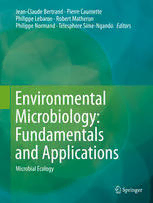
Environmental Microbiology: Fundamentals and Applications: Microbial Ecology PDF
Preview Environmental Microbiology: Fundamentals and Applications: Microbial Ecology
Jean-Claude Bertrand · Pierre Caumette Philippe Lebaron · Robert Matheron Editors Philippe Normand · Télesphore Sime-Ngando Environmental Microbiology: Fundamentals and Applications Microbial Ecology Environmental Microbiology: Fundamentals and Applications Jean-Claude Bertrand • Pierre Caumette Philippe Lebaron • Robert Matheron Philippe Normand • Te´lesphore Sime-Ngando Editors Environmental Microbiology: Fundamentals and Applications Microbial Ecology Editors Jean-ClaudeBertrand PierreCaumette InstitutMe´diterrane´en InstitutdesSciencesAnalytiquesetdePhysico-chimiepour d’Oce´anologie(MIO) l’EnvironnementetlesMate´riaux(IPREM) UM110,CNRS7294IRD235, UMRCNRS5254,Universite´dePauetdesPaysdel’Adour Universite´deToulon,Aix-Marseille PauCedex,France Universite´ MarseilleCedex9,France RobertMatheron InstitutMe´diterrane´endeBiodiversite´et PhilippeLebaron d’Ecologiemarineetcontinentale(IMBE) ObservatoireOce´anologiquedeBanyuls, UMR-CNRS-IRD7263,Aix-MarseilleUniversite´ LaboratoiredeBiodiversite´et MarseilleCedex20,France BiotechnologieMicrobiennes(LBBM) SorbonneUniversite´s,UPMCUniv Te´lesphoreSime-Ngando Paris06,USRCNRS3579 LaboratoireMicroorganismes:Ge´nome Banyuls-sur-Mer,France etEnvironnement(LMGE) UMRCNRS6023,Universite´BlaisePascal, PhilippeNormand ClermontUniversite´ MicrobialEcologyCenter Aube`reCedex,France UMRCNRS5557/USCINRA1364 Villeurbanne,France Editors Jean-ClaudeBertrand PierreCaumette PhilippeLebaron RobertMatheron PhilippeNormand Title E´cologiemicrobienne Microbiologiedesmilieuxnaturelsetanthropise´s Publisher/Location PressesUniversitairesdePauetdesPaysdel’Adour www.presses-univ-pau.fr Copyrightyear:2011 Translation ThecontributingauthorsintheirroleastranslatorsofthechaptersfromFrenchtoEnglish. Content Updated(previouslypublishedcontent—intheFrenchtitle—butnowincludes updatedmaterialand/orsectionsthathavebeenadded) ISBN978-94-017-9117-5 ISBN978-94-017-9118-2(eBook) DOI10.1007/978-94-017-9118-2 SpringerDordrechtHeidelbergNewYorkLondon LibraryofCongressControlNumber:2014956023 #SpringerScience+BusinessMediaDordrecht2015 Thisworkissubjecttocopyright.AllrightsarereservedbythePublisher,whetherthewholeorpartofthematerialis concerned,specificallytherightsoftranslation,reprinting,reuseofillustrations,recitation,broadcasting,reproduction on microfilms or in any other physical way, and transmission or information storage and retrieval, electronic adaptation, computer software, or by similar or dissimilar methodology now known or hereafter developed. Exemptedfromthislegalreservationarebriefexcerptsinconnectionwithreviewsorscholarlyanalysisormaterial suppliedspecificallyforthepurposeofbeingenteredandexecutedonacomputersystem,forexclusiveusebythe purchaserofthework.Duplicationofthispublicationorpartsthereofispermittedonlyundertheprovisionsofthe CopyrightLawofthePublisher’slocation,initscurrentversion,andpermissionforusemustalwaysbeobtainedfrom Springer.PermissionsforusemaybeobtainedthroughRightsLinkattheCopyrightClearanceCenter.Violationsare liabletoprosecutionundertherespectiveCopyrightLaw. Theuseofgeneraldescriptivenames,registerednames,trademarks,servicemarks,etc.inthispublicationdoesnot imply,evenintheabsenceofaspecificstatement,thatsuchnamesareexemptfromtherelevantprotectivelawsand regulationsandthereforefreeforgeneraluse. Whiletheadviceandinformationinthisbookarebelievedtobetrueandaccurateatthedateofpublication,neitherthe authorsnortheeditorsnorthepublishercanacceptanylegalresponsibilityforanyerrorsoromissionsthatmaybe made.Thepublishermakesnowarranty,expressorimplied,withrespecttothematerialcontainedherein. Printedonacid-freepaper SpringerispartofSpringerScience+BusinessMedia(www.springer.com) Preface The average citizen thinks of microbes as dangerous or at least as nasty enemies to her/his healththatshe/hecannotsee.Theinvisibilitytothenakedeyeisthereasonwhymicrobesare sopoorlyknown,theirwideactionandimportanceinnaturealmostfullyneglected.Andthis also has the consequence that they play no or only a subordinate role in the international conventions for the protection of species. The French born English writer Hilaire Belloc (1870–1953)putthisdilemmaintoasimplepoemthatstarts:“Themicrobeissoverysmall, you cannot make him out at all, but many sanguine people hope to see him through the microscope ...”. There is no doubt, that only a minority of people have the opportunity todosoandthusthemajoritystaysignorantandcontinuestoharboronlythenegativeimage ofmicrobes. Thisbookaboutmicrobialecologywillopentheignoranteyestounderstandandappreciate theroleandimportanceoftheubiquitous“invisiblemicrobes”innatureaswellasindailylife. Inthetwenty-firstcentury,withmankindfacingnewthreatslikecontaminationofsoils,rivers, the oceans, air pollution, global warming, climate change, desertification, newly evolving diseases,etc.,itisnecessary–morethaneverbefore–toassesstheimportanceofmicrobes, of their ecological behavior and implication in these processes. A prerequisite for that is a multi-facetted knowledge of microbes, their diversity, their metabolism, their interactions, the ecological rules controlling them and the biotopes they inhabit. Tools and methods for the study of ecological interactions are as necessary as the physicochemical axioms and mathematics behind them. Ecology is predominantly seen as an outdoor science, but has by principle two quite different localities of research: Laboratory work is as important as the study of the sometimes rather inaccessible natural habitats. It is essential for the modern ecologisttobeascompetentandexperiencedinthefieldasatthelabbench. The six editors of this book, Jean Claude Bertrand, Pierre Caumette, Philippe Lebaron, RobertMatheron,PhilippeNormandandTe´lesphoreSime-Ngandoaretobecongratulatedfor findingsuchaperfectlistofauthorialteams,allverywellknownexpertsinthefield.Thebook is divided in five parts: “general chapters”, “taxonomy and evolution”, “microbial habitats”, “roleandfunctioningofmicrobialecosystems”,and“toolsandmicrobialgeneticsappliedto the environment”, each containing 3–5 chapters, altogether written by 59 authors, of whom many were involved in more than one chapter. Thirteen chapters are co-authored by one or moreoftheeditors!Thusandbymeansofmultipleauthorshiptheeditorsmadesurethatthe book comes out as a single consistent effort, not a collection of more or less divergent chapters.Asacomprehensivetreatiseitdefinitelyhasachancetobecomeatleastanimportant referenceandtextbookforgraduateandpostgraduatestudentsinmicrobialecology,butmost probablyingeneralmicrobiology,too.Textbooksingeneralmicrobiology(withexceptions) usually put emphasis on metabolism, systematics, structure etc., not on ecology. This book, however,positionsecologyatthecenterandtheotherfieldsaroundit.Quiteoftenonemisses themicrobialeukaryotesorvirusesinmicrobialecologybooks.Notinthisone.Thisisanall microbes embracing effort and therefore constitutes a complete treatise of the field. What is welcomed andemphasizesthecompletenessofthebookisthatitdevotesonechaptertothe history of microbial ecology, depicting the development of theories, increase of knowledge, changes in thinking over the centuries towards more modern and global views. In other v vi Preface chapters, historical aspects are also mentioned where necessary. Divergent ideas and conceptionsarenotsuppressed,butopenlydiscussed,asscientificdisputedemands. Therefore it will gain the full attention of not only microbial ecologists, but of all microbiologists who need to modernize their views of ecology. Also plant and animal ecologists in general should brush up their knowledge on the often neglected part that microbes play in the global environment. For all who are involved in contamination and remediationofsoilsandwaters,inwastetreatment,inlandscaping,inmaintenanceofnatural resorts, food microbiology, biotechnology, phytopathology, medical and veterinarian micro- biology,thisbookcontainsvaluableinformation.Thistreatiseisrelevantforeveryaspectof modernmicrobiologyandbelongsintothehandofeverymicrobiologist. Personswhohavestudiedthisbookthoroughlywillbeabletoappreciatetheprofoundtruth of Louis Pasteur’s sentence: “Ce sont les microbes qui auront le dernier mot” (“It is the microbesthatwillhavethelastsay”). Bonn,Germany HansG.Tru¨per Acknowledgements Wearegratefultoallthosewhohelpedustoachievethisbookwhosepublicationhasrequired theassistanceandcommentsofmanycontributors. MostoftheillustrationsareduetothetalentofMarie-Jose´eBodiouandVale´rieDomien, graphicdesignersatAragoLaboratoryinBanyuls-sur-mer,whosecontributionwasindispens- able to the realization of the work; we wish to thank both very much for all the work accomplishedwithskillandgoodhumor. Ourthanksalsogotothefollowingpersonswhowereresponsibleforproofreadingpartsof thebook,whoexpressedconstructivecriticism,orhelpeduswiththeirskills:MichelGuiliano, Fortunat Joos, Dominique Lefevre, Louis Legendre, Roland Marmeisse, Danielle Marty, Gilbert Mille, Fereidoun Rassoulzadegan, Marc Troussellier, Francesca Vidussi, and all membersoftheGDR“FoodWebs.” vii Contents PartI GeneralChapters 1 TheThematicFieldsofMicrobialEcology. . . . . . . . . . . . . . . . . . . . . . . . . 3 Jean-ClaudeBertrand,PierreCaumette,PhilippeLebaron, andPhilippeNormand 2 SomeHistoricalElementsofMicrobialEcology. . . . . . . . . . . . . . . . . . . . . 9 PierreCaumette,Jean-ClaudeBertrand,andPhilippeNormand 3 StructureandFunctionsofMicroorganisms:Production andUseofMaterialandEnergy. . . . . . . . . . . . . . . . . . . . . . . . . . . . . . . . . 25 RobertMatheronandPierreCaumette PartII TaxonomyandEvolution 4 ForThreeBillionYears,MicroorganismsWeretheOnly InhabitantsoftheEarth. . . . . . . . . . . . . . . . . . . . . . . . . . . . . . . . . . . . . . . 75 Jean-ClaudeBertrand,Ce´lineBrochier-Armanet, ManoloGouy,andFrancesWestall 5 SystematicandEvolutionofMicroorganisms:GeneralConcepts. . . . . . . . 107 Charles-Franc¸oisBoudouresque,PierreCaumette,Jean-ClaudeBertrand, PhilippeNormand,andTe´lesphoreSime-Ngando 6 TaxonomyandPhylogenyofProkaryotes. . . . . . . . . . . . . . . . . . . . . . . . . . 145 PierreCaumette,Ce´lineBrochier-Armanet,andPhilippeNormand 7 TaxonomyandPhylogenyofUnicellularEukaryotes. . . . . . . . . . . . . . . . . 191 Charles-Franc¸oisBoudouresque PartIII MicrobialHabitats:Diversity,AdaptationandInteractions 8 BiodiversityandMicrobialEcosystemsFunctioning. . . . . . . . . . . . . . . . . . 261 PhilippeNormand,RobertDuran,XavierLeRoux,CindyMorris, andJean-ChristophePoggiale 9 AdaptationsofProkaryotestoTheirBiotopesandtoPhysicochemical ConditionsinNaturalorAnthropizedEnvironments. . . . . . . . . . . . . . . . . 293 PhilippeNormand,PierreCaumette,PhilippeGoulas, PetarPujic,andFlorenceWisniewski-Dye´ 10 TheExtremeConditionsofLifeonthePlanetandExobiology. . . . . . . . . . 353 Jean-LucCayol,BernardOllivier,DidierAlazard,RicardoAmils, AnneGodfroy,FlorencePiette,andDanielPrieur ix
